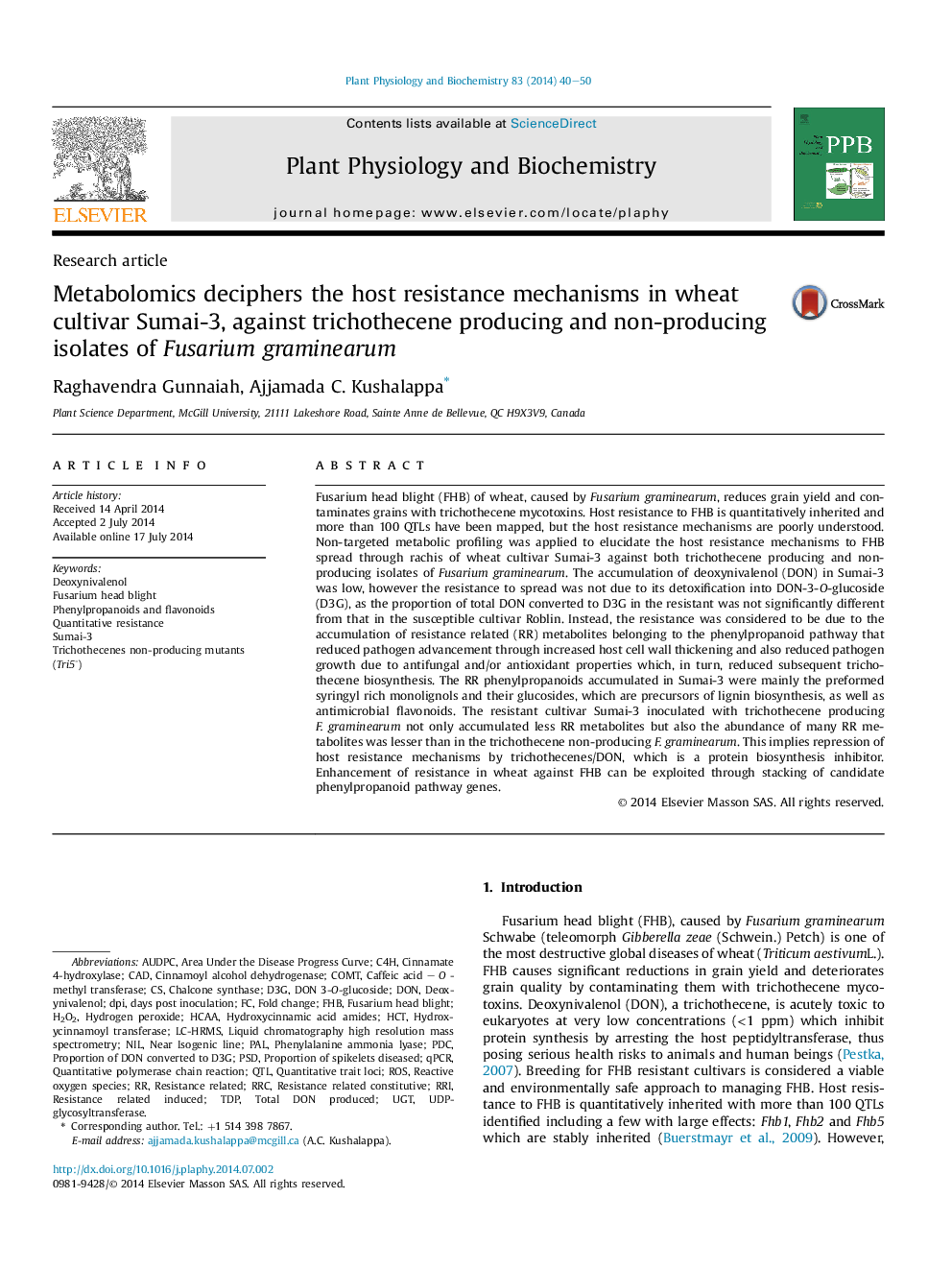| کد مقاله | کد نشریه | سال انتشار | مقاله انگلیسی | نسخه تمام متن |
|---|---|---|---|---|
| 2015754 | 1541938 | 2014 | 11 صفحه PDF | دانلود رایگان |
عنوان انگلیسی مقاله ISI
Metabolomics deciphers the host resistance mechanisms in wheat cultivar Sumai-3, against trichothecene producing and non-producing isolates of Fusarium graminearum
دانلود مقاله + سفارش ترجمه
دانلود مقاله ISI انگلیسی
رایگان برای ایرانیان
کلمات کلیدی
QTLRRIRRCTDPNILCOMTFHBD3GHCTDeoxynivalenolUGTPALAUDPCDPInear isogenic lineqPCRUDP-glycosyltransferasePSDPDCC4HLC-HRMS - LC HRMSROS - ROSHydrogen peroxide - آب اکسیژنهQuantitative trait loci - تعداد صفات صفاتfold change - تغییر در برابرDON - دونdays post inoculation - روز بعد از تلقیحFusarium head blight - سر Fusarium سرگیجه داردchalcone synthase - سنتاز چالکونcinnamate 4-hydroxylase - سینامات 4-هیدروکسیلازCAD - طراحی به کمک رایانه یا کَدLiquid chromatography high resolution mass spectrometry - طیف سنجی جرمی با وضوح بالا کروماتوگرافی مایعPhenylalanine ammonia lyase - فنیل آلانین آمونیاک لیائازquantitative resistance - مقاومت کمیH2O2 - هیدروژن پراکسیدhydroxycinnamoyl transferase - هیدروکسی سینمویل ترانسفرازHydroxycinnamic acid amides - هیدروکسین کیمیا اسید آمیدquantitative polymerase chain reaction - واکنش زنجیره ای پلیمراز کمیReactive oxygen species - گونههای فعال اکسیژن
موضوعات مرتبط
علوم زیستی و بیوفناوری
علوم کشاورزی و بیولوژیک
دانش گیاه شناسی
پیش نمایش صفحه اول مقاله

چکیده انگلیسی
Fusarium head blight (FHB) of wheat, caused by Fusarium graminearum, reduces grain yield and contaminates grains with trichothecene mycotoxins. Host resistance to FHB is quantitatively inherited and more than 100 QTLs have been mapped, but the host resistance mechanisms are poorly understood. Non-targeted metabolic profiling was applied to elucidate the host resistance mechanisms to FHB spread through rachis of wheat cultivar Sumai-3 against both trichothecene producing and non-producing isolates of Fusarium graminearum. The accumulation of deoxynivalenol (DON) in Sumai-3 was low, however the resistance to spread was not due to its detoxification into DON-3-O-glucoside (D3G), as the proportion of total DON converted to D3G in the resistant was not significantly different from that in the susceptible cultivar Roblin. Instead, the resistance was considered to be due to the accumulation of resistance related (RR) metabolites belonging to the phenylpropanoid pathway that reduced pathogen advancement through increased host cell wall thickening and also reduced pathogen growth due to antifungal and/or antioxidant properties which, in turn, reduced subsequent trichothecene biosynthesis. The RR phenylpropanoids accumulated in Sumai-3 were mainly the preformed syringyl rich monolignols and their glucosides, which are precursors of lignin biosynthesis, as well as antimicrobial flavonoids. The resistant cultivar Sumai-3 inoculated with trichothecene producing F. graminearum not only accumulated less RR metabolites but also the abundance of many RR metabolites was lesser than in the trichothecene non-producing F. graminearum. This implies repression of host resistance mechanisms by trichothecenes/DON, which is a protein biosynthesis inhibitor. Enhancement of resistance in wheat against FHB can be exploited through stacking of candidate phenylpropanoid pathway genes.
ناشر
Database: Elsevier - ScienceDirect (ساینس دایرکت)
Journal: Plant Physiology and Biochemistry - Volume 83, October 2014, Pages 40-50
Journal: Plant Physiology and Biochemistry - Volume 83, October 2014, Pages 40-50
نویسندگان
Raghavendra Gunnaiah, Ajjamada C. Kushalappa,